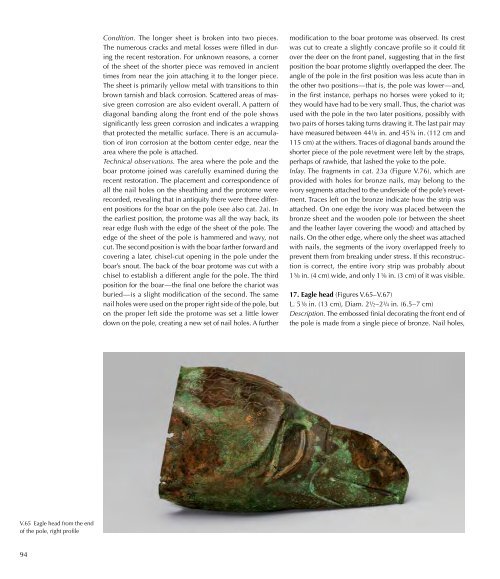Journal - Comune di Monteleone di Spoleto
Journal - Comune di Monteleone di Spoleto
Journal - Comune di Monteleone di Spoleto
Create successful ePaper yourself
Turn your PDF publications into a flip-book with our unique Google optimized e-Paper software.
V.65 eagle head from the end<br />
of the pole, right profile<br />
94<br />
Con<strong>di</strong>tion. The longer sheet is broken into two pieces.<br />
The numerous cracks and metal losses were filled in during<br />
the recent restoration. For unknown reasons, a corner<br />
of the sheet of the shorter piece was removed in ancient<br />
times from near the join attaching it to the longer piece.<br />
The sheet is primarily yellow metal with transitions to thin<br />
brown tarnish and black corrosion. Scattered areas of massive<br />
green corrosion are also evident overall. a pattern of<br />
<strong>di</strong>agonal ban<strong>di</strong>ng along the front end of the pole shows<br />
significantly less green corrosion and in<strong>di</strong>cates a wrapping<br />
that protected the metallic surface. There is an accumulation<br />
of iron corrosion at the bottom center edge, near the<br />
area where the pole is attached.<br />
Technical observations. The area where the pole and the<br />
boar protome joined was carefully examined during the<br />
recent restoration. The placement and correspondence of<br />
all the nail holes on the sheathing and the protome were<br />
recorded, revealing that in antiquity there were three <strong>di</strong>fferent<br />
positions for the boar on the pole (see also cat. 2a). in<br />
the earliest position, the protome was all the way back, its<br />
rear edge flush with the edge of the sheet of the pole. The<br />
edge of the sheet of the pole is hammered and wavy, not<br />
cut. The second position is with the boar farther forward and<br />
covering a later, chisel-cut opening in the pole under the<br />
boar’s snout. The back of the boar protome was cut with a<br />
chisel to establish a <strong>di</strong>fferent angle for the pole. The third<br />
position for the boar — the final one before the chariot was<br />
buried — is a slight mo<strong>di</strong>fication of the second. The same<br />
nail holes were used on the proper right side of the pole, but<br />
on the proper left side the protome was set a little lower<br />
down on the pole, creating a new set of nail holes. a further<br />
mo<strong>di</strong>fication to the boar protome was observed. its crest<br />
was cut to create a slightly concave profile so it could fit<br />
over the deer on the front panel, suggesting that in the first<br />
position the boar protome slightly overlapped the deer. The<br />
angle of the pole in the first position was less acute than in<br />
the other two positions — that is, the pole was lower — and,<br />
in the first instance, perhaps no horses were yoked to it;<br />
they would have had to be very small. Thus, the chariot was<br />
used with the pole in the two later positions, possibly with<br />
two pairs of horses taking turns drawing it. The last pair may<br />
have measured between 44 1⁄8 in. and 45 ¼ in. (112 cm and<br />
115 cm) at the withers. Traces of <strong>di</strong>agonal bands around the<br />
shorter piece of the pole revetment were left by the straps,<br />
perhaps of rawhide, that lashed the yoke to the pole.<br />
Inlay. The fragments in cat. 23a (Figure V.76), which are<br />
provided with holes for bronze nails, may belong to the<br />
ivory segments attached to the underside of the pole’s revetment.<br />
Traces left on the bronze in<strong>di</strong>cate how the strip was<br />
attached. on one edge the ivory was placed between the<br />
bronze sheet and the wooden pole (or between the sheet<br />
and the leather layer covering the wood) and attached by<br />
nails. on the other edge, where only the sheet was attached<br />
with nails, the segments of the ivory overlapped freely to<br />
prevent them from breaking under stress. if this reconstruction<br />
is correct, the entire ivory strip was probably about<br />
1 5⁄8 in. (4 cm) wide, and only 1 1⁄8 in. (3 cm) of it was visible.<br />
17. Eagle head (Figures V.65– V.67)<br />
l. 5 1⁄8 in. (13 cm), <strong>di</strong>am. 2 1⁄2 – 2 3⁄4 in. (6.5 – 7 cm)<br />
Description. The embossed finial decorating the front end of<br />
the pole is made from a single piece of bronze. nail holes,


